Parseval Airships on:
[Wikipedia]
[Google]
[Amazon]
The Parsevals were 22 
 The ''Versuchsluftschiff'' (meaning experimental airship) was Parseval's first model. It was rebuilt several times.
*First flight on 26 May 1906 at Berlin's Tegel, a military field
*Pilot: Captain von Krogh
*Length: 48 m, Diameter: 4.8 m
*Power plant: 62 kW (85 PS) Daimler-Motor
*Max speed: 43.2 km/h
*The hull was completed by the balloon constructer Riedinger and was later increased from 2300 to 2800 cubic metre, the length increased to 50 m
*After all the modifications were completed, from 1909 it was designated "PL 1".
The ''Versuchsluftschiff'' (meaning experimental airship) was Parseval's first model. It was rebuilt several times.
*First flight on 26 May 1906 at Berlin's Tegel, a military field
*Pilot: Captain von Krogh
*Length: 48 m, Diameter: 4.8 m
*Power plant: 62 kW (85 PS) Daimler-Motor
*Max speed: 43.2 km/h
*The hull was completed by the balloon constructer Riedinger and was later increased from 2300 to 2800 cubic metre, the length increased to 50 m
*After all the modifications were completed, from 1909 it was designated "PL 1".
 *Developed from the ''Versuchluftschiff''
*Maiden flight: 1909-09-21
*Volume: 3200 m³, 60 m length, 9.4 m Diameter
*Power plant: a 62 kW (85 PS) Daimler-Motor, a 4.25 m-prop
*On 21 and 22 September 1909 three test flights, improvements to steering and hull, afterwards transported by train Zug to Zürich for the Gordon Bennet Ballon-Races, four demonstration flights in Zürich. The Swiss airship department provided gas filling services, and the chief of the Swiss military general staff was among the passengers for the first flight over Swiss soil.
*In February 1910 was used as the "''Kaiserliche Aero-Klub-Luftschiff''" (Imperial air-club airship) and in
*Developed from the ''Versuchluftschiff''
*Maiden flight: 1909-09-21
*Volume: 3200 m³, 60 m length, 9.4 m Diameter
*Power plant: a 62 kW (85 PS) Daimler-Motor, a 4.25 m-prop
*On 21 and 22 September 1909 three test flights, improvements to steering and hull, afterwards transported by train Zug to Zürich for the Gordon Bennet Ballon-Races, four demonstration flights in Zürich. The Swiss airship department provided gas filling services, and the chief of the Swiss military general staff was among the passengers for the first flight over Swiss soil.
*In February 1910 was used as the "''Kaiserliche Aero-Klub-Luftschiff''" (Imperial air-club airship) and in
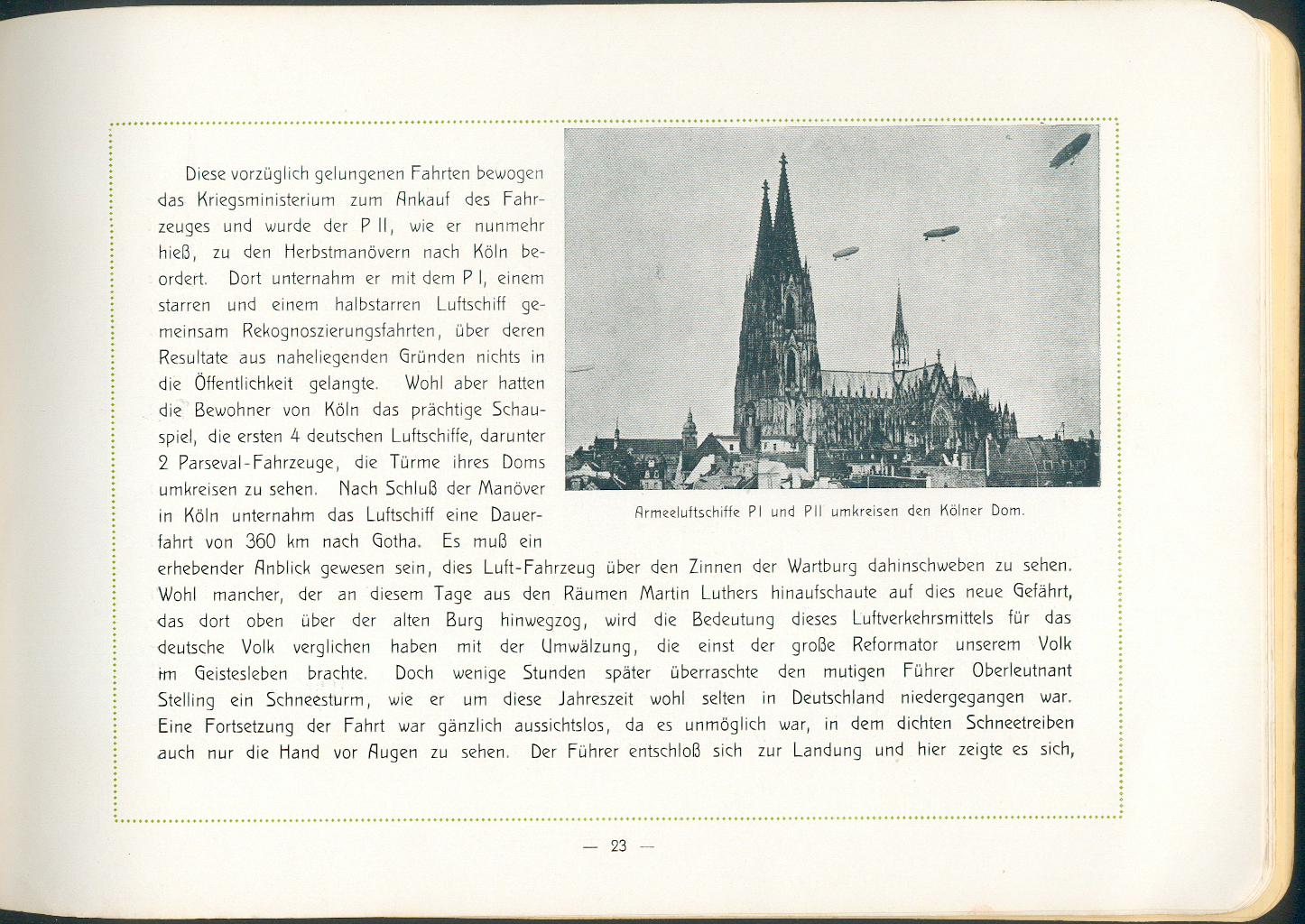 *Built for the Prussian army, under the marking P.I, construction similar to the PL 1.
*Maiden flight: 1908-08-13, in service until 1912 then dismantled.
*Volume: 4000 m³
*Length: 60 m, Diameter: 10.4 m
*Power plant: a 62 kW (85 PS) Daimler-Motor with one airprop
*45 km/h max speed
*Built for the Prussian army, under the marking P.I, construction similar to the PL 1.
*Maiden flight: 1908-08-13, in service until 1912 then dismantled.
*Volume: 4000 m³
*Length: 60 m, Diameter: 10.4 m
*Power plant: a 62 kW (85 PS) Daimler-Motor with one airprop
*45 km/h max speed
 *After seven flights, the hull volume was enlarged on 1909-03-23 from 5600 to 6600m³, refilling starts 1909-06-05, length remains at 70 m, diameter increased by one metre to 11.3 m, test flight 1909-06-28 in Bitterfeld
*Regular passenger flights with up to seven passengers and 4 crew from the International air exhibition in Frankfurt/Main from 7 August until the end of October 1909. Total 74 flights.
*Put out of service after flying into the sea on 1910-05-16
*Power plant: two 81 kW (110 PS) N.A.G.-Motors, each driving a four-bladed airprop
*max speed: 51 km/h
*After seven flights, the hull volume was enlarged on 1909-03-23 from 5600 to 6600m³, refilling starts 1909-06-05, length remains at 70 m, diameter increased by one metre to 11.3 m, test flight 1909-06-28 in Bitterfeld
*Regular passenger flights with up to seven passengers and 4 crew from the International air exhibition in Frankfurt/Main from 7 August until the end of October 1909. Total 74 flights.
*Put out of service after flying into the sea on 1910-05-16
*Power plant: two 81 kW (110 PS) N.A.G.-Motors, each driving a four-bladed airprop
*max speed: 51 km/h
 *PL 4 was purchased by the
*PL 4 was purchased by the
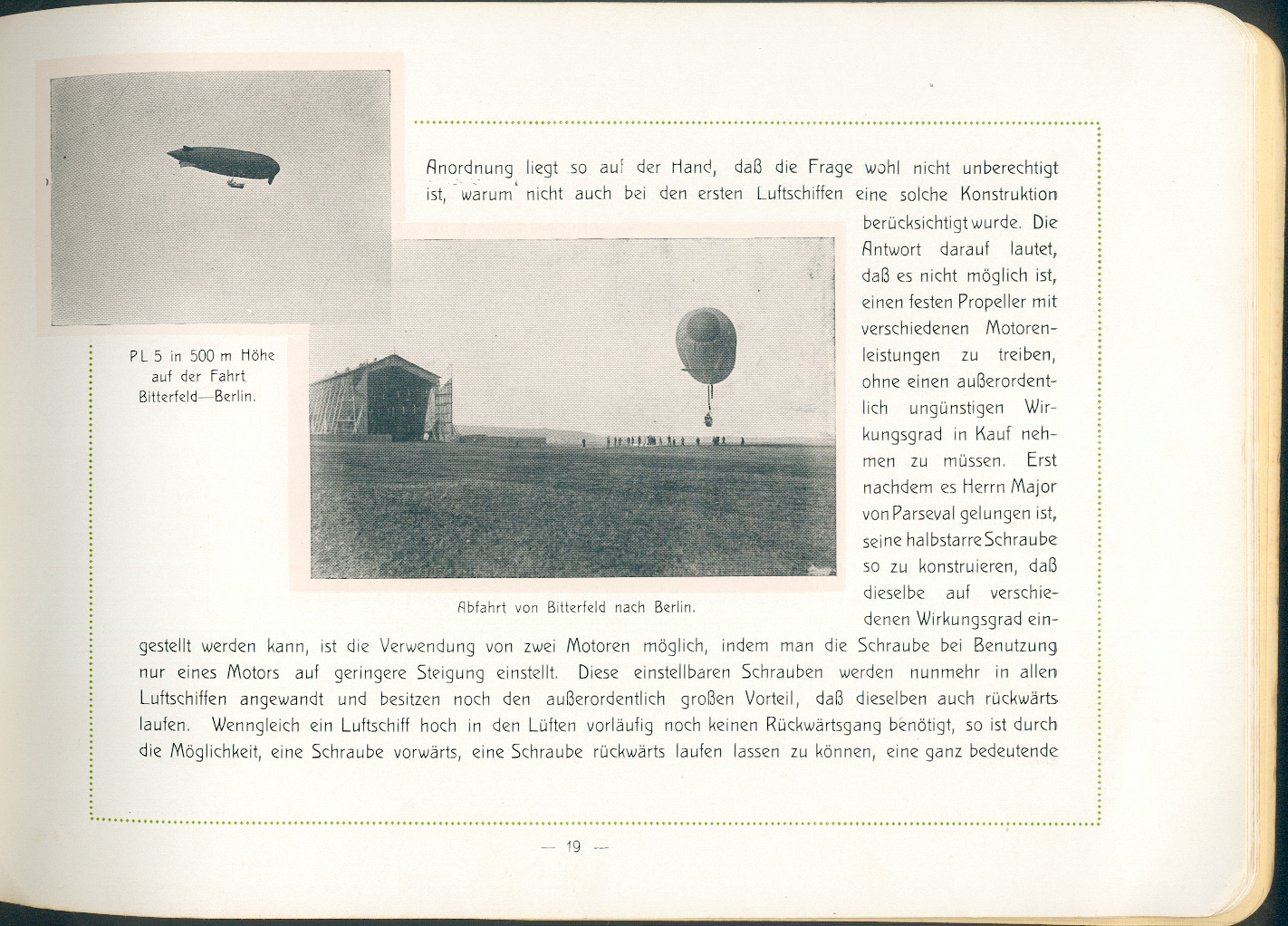 *Over 150 passenger flights
*Stationed at Flughafen Klein Gandau in Breslau (Wroclaw, Poland)
*On 1911-06-11 destroyed in a fire while emptying the gas hull in Münden, later replaced by PL 9
*Volume 1350 m³
*Max speed:
*Flight duration 5 hours
*Flying ceiling: 1,000 metres
*Crew and passengers: 3 to 4
*Over 150 passenger flights
*Stationed at Flughafen Klein Gandau in Breslau (Wroclaw, Poland)
*On 1911-06-11 destroyed in a fire while emptying the gas hull in Münden, later replaced by PL 9
*Volume 1350 m³
*Max speed:
*Flight duration 5 hours
*Flying ceiling: 1,000 metres
*Crew and passengers: 3 to 4
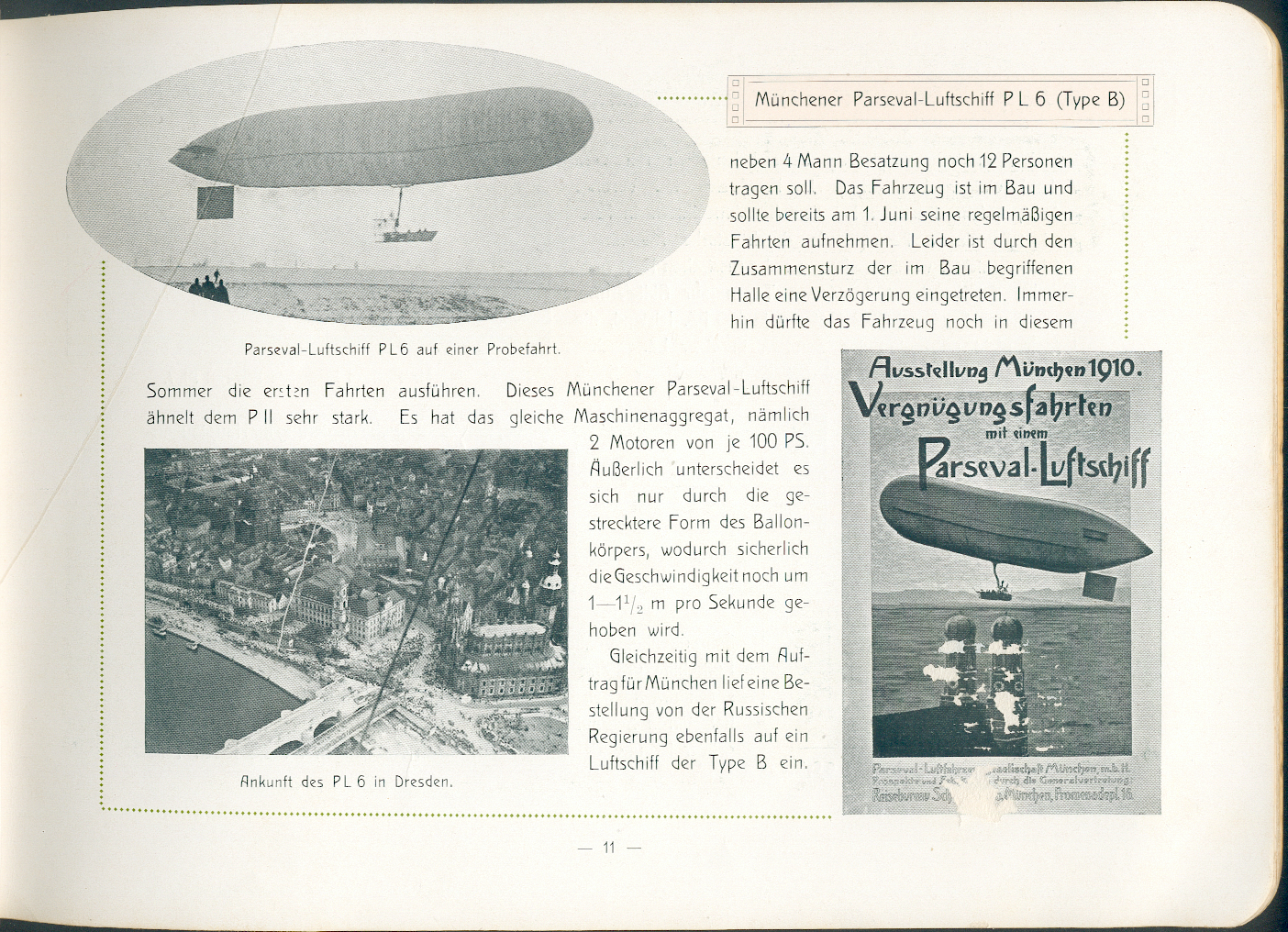 *Maiden flight 1910-06-30,
*Intended for round trips
*Up to 12 passengers, 4 crew,
*First use of night air advertising on an airship, a projector could project images on its hull
*Modernised in 1912 to bring it to same technical standard as the PL 12, volume increased from 6800 to 8000 m³
*Maiden flight 1910-06-30,
*Intended for round trips
*Up to 12 passengers, 4 crew,
*First use of night air advertising on an airship, a projector could project images on its hull
*Modernised in 1912 to bring it to same technical standard as the PL 12, volume increased from 6800 to 8000 m³
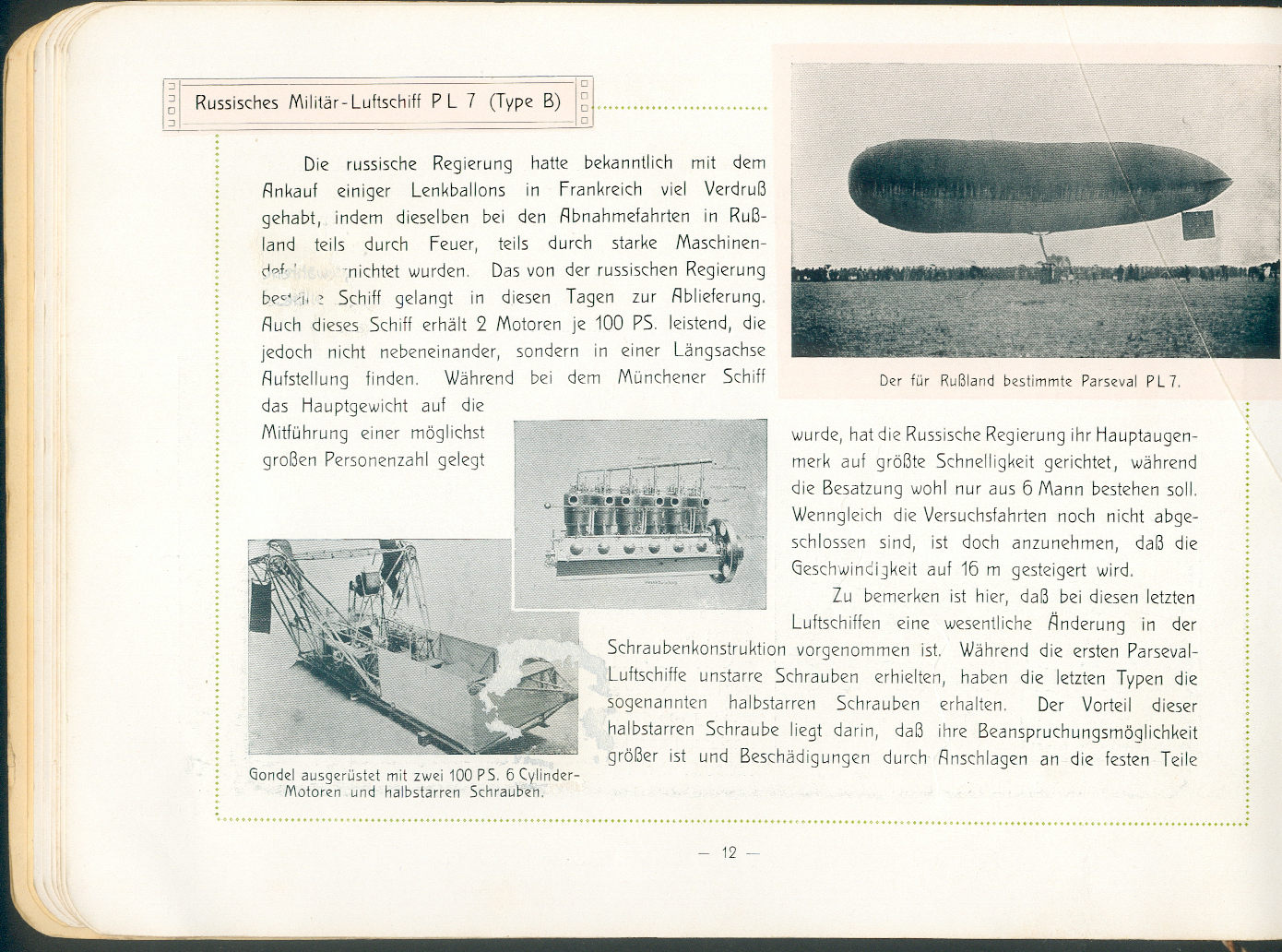 *Delivered to Russia with the marking ''Grif'' (Griffin), see also
*Delivered to Russia with the marking ''Grif'' (Griffin), see also
Smartsoft Ltf, 2008 *Volume: 6700 m³ *Length 72 m, diameter 14 m *Max speed: , possibly with only 6 persons *Flight duration: 20 hours or longer *Flight ceiling: 2500 metre *Crew and passengers: 12-16 *Crew: 3-4 *The Luft-Fahrzeug-Gesellschaft brochure shows the PL 7 (Type B), intended for the Russian military, one of its six-cylinder 100 PS engines, and its gondola with two engines driving semi-rigid props
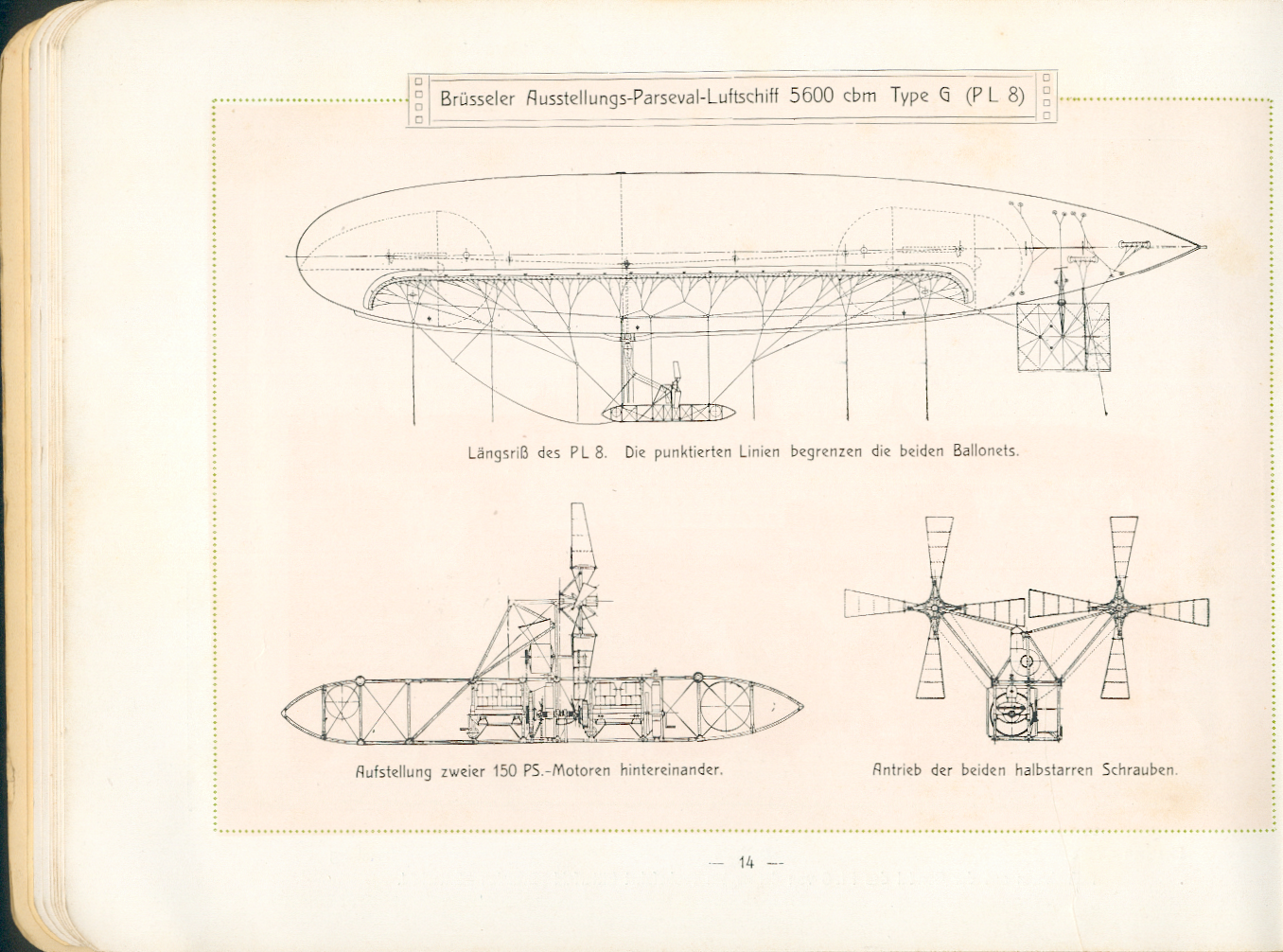 *PL 8 delivered to Prussian army on 1913-03-12, with marking ''Ersatz P.II'' (P.II replacement)
*Volume: 5600 m³
*Max speed: 16–17 m/s
*Flight duration: >= 20 h
*Flight ceiling: 2000 m
*Passengers and crew: 7-12
*Crew: 4
*Power plant: Two 150 PS engines each driving a four-bladed airprop
*PL 8 delivered to Prussian army on 1913-03-12, with marking ''Ersatz P.II'' (P.II replacement)
*Volume: 5600 m³
*Max speed: 16–17 m/s
*Flight duration: >= 20 h
*Flight ceiling: 2000 m
*Passengers and crew: 7-12
*Crew: 4
*Power plant: Two 150 PS engines each driving a four-bladed airprop
 *Maiden flight: 23. April 1913
*1913 delivered to the
*Maiden flight: 23. April 1913
*1913 delivered to the
 ''See: Parseval PL25''
PL 25 was a military airship made in 1914/1915. It was the last single-gondola Parseval airship. It made its first flight on 1915-02-25, entered Navy service until 1916, after 95 flights.
''See: Parseval PL25''
PL 25 was a military airship made in 1914/1915. It was the last single-gondola Parseval airship. It made its first flight on 1915-02-25, entered Navy service until 1916, after 95 flights.
Airships: Misconceptions and Myths First Part of Three
, 2005-02-09. Retrieved 2008-06-11. The owner was "AB Luftskeppsreklam i Stockholm" (Airship Advertising Co). Sidenhuset's task was to make advertising flights over the 1930 Stockholm Exhibition (Stockholmsutställningen). The airship was damaged by wind due to its being parked outside. The manufacturer arrived and it was decided to fly the ship back to Germany for repairs. During the fight it crashed into the
Luftschiffahrt
Dem heutigen Stande der Wissenschaft entsprechend dargestellt von Regierungsbaumeister K. Hackstetter, Oberingenieur Siegfried Hartmann, Regierungsrat Hofmann, Leutnant Ernst Mickel, Emil Sandt, Oberleutnant a. D. Stelling, Dr.P. Schulze, und Graf Ferdinand von Zeppelin, 1908
images of early airships Lists of airships Airships of Germany Parseval Aviation in World War I 1900s German aircraft 1910s German aircraft 1920s German aircraft German military aircraft
airship
An airship or dirigible balloon is a type of aerostat or lighter-than-air aircraft that can navigate through the air under its own power. Aerostats gain their lift from a lifting gas that is less dense than the surrounding air.
In early ...
s built between 1909 and 1919 by the Luft-Fahrzeug-Gesellschaft (LFG) following the design of August von Parseval. In the 1920s and 1930s, three more airships were built following the Parseval-Naatz (PN) design.
As with the rival Zeppelin
A Zeppelin is a type of rigid airship named after the German inventor Count Ferdinand von Zeppelin () who pioneered rigid airship development at the beginning of the 20th century. Zeppelin's notions were first formulated in 1874Eckener 1938, pp ...
s, the airships were, in both English
English usually refers to:
* English language
* English people
English may also refer to:
Peoples, culture, and language
* ''English'', an adjective for something of, from, or related to England
** English national ide ...
and German
German(s) may refer to:
* Germany (of or related to)
** Germania (historical use)
* Germans, citizens of Germany, people of German ancestry, or native speakers of the German language
** For citizens of Germany, see also German nationality law
**Ge ...
, referred to by the name of the inventor. (In German, the nouns were masculine, that is, "''der Parseval''", "''der Zeppelin''".)
In contrast to the Zeppelins, the Parsevals were non-rigid or semi-rigid airships, with little or no stiffening structure inside the fabric envelope. The Zeppelins had a rigid internal framework made of duralumin. Both types relied on hydrogen
Hydrogen is the chemical element with the symbol H and atomic number 1. Hydrogen is the lightest element. At standard conditions hydrogen is a gas of diatomic molecules having the formula . It is colorless, odorless, tasteless, non-toxic ...
gas to provide lift.

Experimental airship
 The ''Versuchsluftschiff'' (meaning experimental airship) was Parseval's first model. It was rebuilt several times.
*First flight on 26 May 1906 at Berlin's Tegel, a military field
*Pilot: Captain von Krogh
*Length: 48 m, Diameter: 4.8 m
*Power plant: 62 kW (85 PS) Daimler-Motor
*Max speed: 43.2 km/h
*The hull was completed by the balloon constructer Riedinger and was later increased from 2300 to 2800 cubic metre, the length increased to 50 m
*After all the modifications were completed, from 1909 it was designated "PL 1".
The ''Versuchsluftschiff'' (meaning experimental airship) was Parseval's first model. It was rebuilt several times.
*First flight on 26 May 1906 at Berlin's Tegel, a military field
*Pilot: Captain von Krogh
*Length: 48 m, Diameter: 4.8 m
*Power plant: 62 kW (85 PS) Daimler-Motor
*Max speed: 43.2 km/h
*The hull was completed by the balloon constructer Riedinger and was later increased from 2300 to 2800 cubic metre, the length increased to 50 m
*After all the modifications were completed, from 1909 it was designated "PL 1".
PL 1
 *Developed from the ''Versuchluftschiff''
*Maiden flight: 1909-09-21
*Volume: 3200 m³, 60 m length, 9.4 m Diameter
*Power plant: a 62 kW (85 PS) Daimler-Motor, a 4.25 m-prop
*On 21 and 22 September 1909 three test flights, improvements to steering and hull, afterwards transported by train Zug to Zürich for the Gordon Bennet Ballon-Races, four demonstration flights in Zürich. The Swiss airship department provided gas filling services, and the chief of the Swiss military general staff was among the passengers for the first flight over Swiss soil.
*In February 1910 was used as the "''Kaiserliche Aero-Klub-Luftschiff''" (Imperial air-club airship) and in
*Developed from the ''Versuchluftschiff''
*Maiden flight: 1909-09-21
*Volume: 3200 m³, 60 m length, 9.4 m Diameter
*Power plant: a 62 kW (85 PS) Daimler-Motor, a 4.25 m-prop
*On 21 and 22 September 1909 three test flights, improvements to steering and hull, afterwards transported by train Zug to Zürich for the Gordon Bennet Ballon-Races, four demonstration flights in Zürich. The Swiss airship department provided gas filling services, and the chief of the Swiss military general staff was among the passengers for the first flight over Swiss soil.
*In February 1910 was used as the "''Kaiserliche Aero-Klub-Luftschiff''" (Imperial air-club airship) and in Bitterfeld
Bitterfeld () is a town in the district of Anhalt-Bitterfeld, Saxony-Anhalt, Germany. Since 1 July 2007 it has been part of the town of Bitterfeld-Wolfen. It is situated approximately 25 km south of Dessau, and 30 km northeast of Halle ( ...
until its end of service
*20 Flights between 21 September 1909 und 21 April 1910, the last flight a forced landing
*Experimented with an image projector (see also PL 6 where advertising images were projected on the hull)
PL 2 / P.I
 *Built for the Prussian army, under the marking P.I, construction similar to the PL 1.
*Maiden flight: 1908-08-13, in service until 1912 then dismantled.
*Volume: 4000 m³
*Length: 60 m, Diameter: 10.4 m
*Power plant: a 62 kW (85 PS) Daimler-Motor with one airprop
*45 km/h max speed
*Built for the Prussian army, under the marking P.I, construction similar to the PL 1.
*Maiden flight: 1908-08-13, in service until 1912 then dismantled.
*Volume: 4000 m³
*Length: 60 m, Diameter: 10.4 m
*Power plant: a 62 kW (85 PS) Daimler-Motor with one airprop
*45 km/h max speed
PL 3 / P.II
 *After seven flights, the hull volume was enlarged on 1909-03-23 from 5600 to 6600m³, refilling starts 1909-06-05, length remains at 70 m, diameter increased by one metre to 11.3 m, test flight 1909-06-28 in Bitterfeld
*Regular passenger flights with up to seven passengers and 4 crew from the International air exhibition in Frankfurt/Main from 7 August until the end of October 1909. Total 74 flights.
*Put out of service after flying into the sea on 1910-05-16
*Power plant: two 81 kW (110 PS) N.A.G.-Motors, each driving a four-bladed airprop
*max speed: 51 km/h
*After seven flights, the hull volume was enlarged on 1909-03-23 from 5600 to 6600m³, refilling starts 1909-06-05, length remains at 70 m, diameter increased by one metre to 11.3 m, test flight 1909-06-28 in Bitterfeld
*Regular passenger flights with up to seven passengers and 4 crew from the International air exhibition in Frankfurt/Main from 7 August until the end of October 1909. Total 74 flights.
*Put out of service after flying into the sea on 1910-05-16
*Power plant: two 81 kW (110 PS) N.A.G.-Motors, each driving a four-bladed airprop
*max speed: 51 km/h
PL 4 - M I
 *PL 4 was purchased by the
*PL 4 was purchased by the Kaiserlich und königlich
The phrase Imperial and Royal ( German: ''kaiserlich und königlich'', ), typically abbreviated as ''k. u. k.'', ''k. und k.'', ''k. & k.'' in German (the "und" is always spoken unabbreviated), ''cs. és k. (császári és királyi)'' in Hungar ...
Military-aero-nautical institute and stationed in Fischamend
Fischamend () is a town in the district of Bruck an der Leitha in the Austrian state of Lower Austria. It belonged to Wien-Umgebung District which was dissolved in 2016.
Population
Geography
Fischamend lies in the "Industrial Quarter" in Low ...
, Wien-Umgebung
Bezirk Wien-Umgebung was a district of the state of Lower Austria in Austria. The district comprised four non-contiguous districts on the outer fringes of Vienna: Klosterneuburg and Gerasdorf to the north of the city, Schwechat to its south-east ...
under the designation "M I"
*Maiden flight: 26. November 1909
*Volume: 2300 m³,
*Power plant: Austro-Daimler-Motors from Wiener Neustadt
Wiener Neustadt (; ; Central Bavarian: ''Weana Neistod'') is a city located south of Vienna, in the state of Lower Austria, in northeast Austria. It is a self-governed city and the seat of the district administration of Wiener Neustadt-Land Distr ...
, either 1x 62 kW or 2x 33 kW (1x 85 or 2x 45 PS), each of which driving a single airprop
*Hull built by an Austrian rubber factory in Wimpassing im Schwarzatale
*Length: 50 m, Diameter 12.5 m,
*Flying ceiling: 1000 metre
*Crew: 2-3, passengers: 4-5 (capacity for 7 persons in total)
PL 5
 *Over 150 passenger flights
*Stationed at Flughafen Klein Gandau in Breslau (Wroclaw, Poland)
*On 1911-06-11 destroyed in a fire while emptying the gas hull in Münden, later replaced by PL 9
*Volume 1350 m³
*Max speed:
*Flight duration 5 hours
*Flying ceiling: 1,000 metres
*Crew and passengers: 3 to 4
*Over 150 passenger flights
*Stationed at Flughafen Klein Gandau in Breslau (Wroclaw, Poland)
*On 1911-06-11 destroyed in a fire while emptying the gas hull in Münden, later replaced by PL 9
*Volume 1350 m³
*Max speed:
*Flight duration 5 hours
*Flying ceiling: 1,000 metres
*Crew and passengers: 3 to 4
PL 6
 *Maiden flight 1910-06-30,
*Intended for round trips
*Up to 12 passengers, 4 crew,
*First use of night air advertising on an airship, a projector could project images on its hull
*Modernised in 1912 to bring it to same technical standard as the PL 12, volume increased from 6800 to 8000 m³
*Maiden flight 1910-06-30,
*Intended for round trips
*Up to 12 passengers, 4 crew,
*First use of night air advertising on an airship, a projector could project images on its hull
*Modernised in 1912 to bring it to same technical standard as the PL 12, volume increased from 6800 to 8000 m³
PL 7 Grif
 *Delivered to Russia with the marking ''Grif'' (Griffin), see also
*Delivered to Russia with the marking ''Grif'' (Griffin), see also Russian airships
This article outlines some of the non-rigid and semi-rigid airships used in or built in Russia and the Soviet Union.
Origins of the Soviet Airship Program
Like other nations in the early 20th century, Russia began researching and developing ...
Dirigibles of Imperial Russia (up to 1917 year)Smartsoft Ltf, 2008 *Volume: 6700 m³ *Length 72 m, diameter 14 m *Max speed: , possibly with only 6 persons *Flight duration: 20 hours or longer *Flight ceiling: 2500 metre *Crew and passengers: 12-16 *Crew: 3-4 *The Luft-Fahrzeug-Gesellschaft brochure shows the PL 7 (Type B), intended for the Russian military, one of its six-cylinder 100 PS engines, and its gondola with two engines driving semi-rigid props
PL 8 Ersatz P.II
 *PL 8 delivered to Prussian army on 1913-03-12, with marking ''Ersatz P.II'' (P.II replacement)
*Volume: 5600 m³
*Max speed: 16–17 m/s
*Flight duration: >= 20 h
*Flight ceiling: 2000 m
*Passengers and crew: 7-12
*Crew: 4
*Power plant: Two 150 PS engines each driving a four-bladed airprop
*PL 8 delivered to Prussian army on 1913-03-12, with marking ''Ersatz P.II'' (P.II replacement)
*Volume: 5600 m³
*Max speed: 16–17 m/s
*Flight duration: >= 20 h
*Flight ceiling: 2000 m
*Passengers and crew: 7-12
*Crew: 4
*Power plant: Two 150 PS engines each driving a four-bladed airprop
PL 9
*Stationed at Flughafen Klein Gandau in Breslau (Wroclaw, Poland) *1913 sold to the Turkish military *First flight inYeşilköy
(; meaning "Green Village"; prior to 1926, San Stefano or Santo Stefano el, Άγιος Στέφανος, Ágios Stéfanos, tr, Ayastefanos) is an affluent neighbourhood ( tr, mahalle) in the district of Bakırköy, Istanbul, Turkey, on the M ...
occurred on 23 July 1913.
PL 10 Sportsluftschiff
*PL 10 1700 m³ ''Sportsluftschiff'' after the first flight in 1910 dismantled and stored in BitterfeldPL 11 - P.III
*PL 11 first flight 1912-03-01, for the Prussian Army designated as P.III until middle 1914PL 12 Charlotte
*''Charlotte'' getauft, *Built for the "Rheinisch-Westfälischen Flug- und Sportplatz-Gesellschaft mbH Wanne - Herten", where it was used for roundtrips *Maiden flight: 1912-05-11 *PL 12 was used as a passenger and advertising airship until 1914. *Length 82 m, diameter 14 m *Power plant: 2x 81 kW (110 PS) NAG-engines *Volume: 8000 m³ *Max speed: 48 km/hPL 13 Yuhi
*1912 delivered as ''Yuhi''(雄飛号) to Japan、In 1916 January 22 Yuhi flew fromTokorozawa
is a city located in Saitama Prefecture, Japan. , the city had an estimated population of 344,194 in 163,675 households and a population density of 4800 persons per km². The total area of the city is .
Geography
Tokorozawa is located in the ce ...
to Osaka
is a designated city in the Kansai region of Honshu in Japan. It is the capital of and most populous city in Osaka Prefecture, and the third most populous city in Japan, following Special wards of Tokyo and Yokohama. With a population of ...
.
January 22 is the memorial day of "skyship" in Japan.
PL 14 Burewestnik
*Delivered as ''Burewestnik'' to RussiaPL 15 - M 3
*1914 delivered as "M 3" toItaly
Italy ( it, Italia ), officially the Italian Republic, ) or the Republic of Italy, is a country in Southern Europe. It is located in the middle of the Mediterranean Sea, and its territory largely coincides with the homonymous geographical ...
PL 16 - P.IV
*Maiden flight: 1913-10-02 *Middle of 1914 delivered to the Prussian army, where it was renamed "P.IV" *In service until 1916-03-24PL 17
*Maiden flight: 1912-12-30 *Delivered to Italy where it served in the army until 1915PL 18 - No.4
 *Maiden flight: 23. April 1913
*1913 delivered to the
*Maiden flight: 23. April 1913
*1913 delivered to the Royal Navy
The Royal Navy (RN) is the United Kingdom's naval warfare force. Although warships were used by English and Scottish kings from the early medieval period, the first major maritime engagements were fought in the Hundred Years' War against ...
, under the marking "Parseval No.4". The British would describe its service as very successful
*Length: 80 m; diameter: 15 m; volume: 8800 m³.
*Power plant: 2x 132 kW (180 PS) Maybach-engines, max speed 68 km/h,
*Crew: 2 officers and 7 men. Radio and Weaponry installed
*Served during the World War I as patrol ship, demobilised in July 1917
PL 19
*PL 19 was intended for the BritishRoyal Navy
The Royal Navy (RN) is the United Kingdom's naval warfare force. Although warships were used by English and Scottish kings from the early medieval period, the first major maritime engagements were fought in the Hundred Years' War against ...
as "Parseval No.5", but upon war's outbreak was used instead by the German Navy. In England Vickers
Vickers was a British engineering company that existed from 1828 until 1999. It was formed in Sheffield as a steel foundry by Edward Vickers and his father-in-law, and soon became famous for casting church bells. The company went public i ...
constructed three replacement hulls and 2 gondolas with identical specifications.
*Maiden flight: 30 August 1914
*Length: 92 m; Diameter: 15 m; Volume: 10,000 m³
*Power plant: two 132 kW (180 PS) Maybach-engines, max speed: 76 km/h,
*On 1915-01-25 after an air attack on Liepāja
Liepāja (; liv, Līepõ; see other names) is a state city in western Latvia, located on the Baltic Sea. It is the largest-city in the Kurzeme Region and the third-largest city in the country after Riga and Daugavpils. It is an important ice-f ...
, Latvia, due to artillery damage made emergency sea-landing and crew taken as Russian prisoners of war
PL 20 - PL 24
PL 20-24 were not built.PL 25
 ''See: Parseval PL25''
PL 25 was a military airship made in 1914/1915. It was the last single-gondola Parseval airship. It made its first flight on 1915-02-25, entered Navy service until 1916, after 95 flights.
''See: Parseval PL25''
PL 25 was a military airship made in 1914/1915. It was the last single-gondola Parseval airship. It made its first flight on 1915-02-25, entered Navy service until 1916, after 95 flights.
PL 26
PL 26 was a semirigid airship whose maiden flight was on 1915-10-26, but it had an accident upon landing and was destroyed in a fire, with no casualties. *Length: 157 m, maximum diameter: 19.5 m *Volume: 31,300 m³ *Max speed: 100 km/h *Power plant: four 177 kW (240 PS) Maybach-enginesPL 27
PL27's maiden flight was on 1917-03-08. The major difference from its predecessor PL 26 was the specification of the gondola. Because it no longer met increased military requirements, it was not put to military service but instead converted to a passenger airship in 1919. TheTreaty of Versailles
The Treaty of Versailles (french: Traité de Versailles; german: Versailler Vertrag, ) was the most important of the peace treaties of World War I. It ended the state of war between Germany and the Allied Powers. It was signed on 28 June ...
resulted in its dismantlement in 1920.
*Length: 157 m, maximum diameter: 19.5 m
*Volume: 31,300 m³
*Maximum speed: 100 km/h
*Power plant: four 177 kW (240 PS) Maybach-engines
*Lifting capacity 18 tonne
The tonne ( or ; symbol: t) is a unit of mass equal to 1000 kilograms. It is a non-SI unit accepted for use with SI. It is also referred to as a metric ton to distinguish it from the non-metric units of the short ton ( United State ...
Parseval-Naatz PN 28
*Semirigid airship *Trumpf-advertising airship, (like the Raab-Katzenstein RK 27) *Built in Seddin/Pommern by the Berlin "Wasser- und Luftfahrzeug GmbH" *Maiden flighton 1929-06-06 in Berlin *Official marking: D-PN28 *Volume: 1800 m³Parseval-Naatz PN 29 Sidenhuset
*Semirigid airship *Built in 1929 as D-PN 29 with a passenger capacity of 5 *Volume: 2300 m³ *Length: 44 m, diameter: 10 m *Power plant: one Siemens-Halske-engine of 75 kW (100 PS) *Max speed 82 km/h *Total flying time: about 600 hours in 200 flights On 1930-05-21 PN 29 acquired the Swedish call-sign "SE-ACG Sidenhuset", after the then well-known ladies boutique from Stockholm. The word "Sidenhuset" was displayed in large letters on its hull.Seve UngermarkAirships: Misconceptions and Myths First Part of Three
, 2005-02-09. Retrieved 2008-06-11. The owner was "AB Luftskeppsreklam i Stockholm" (Airship Advertising Co). Sidenhuset's task was to make advertising flights over the 1930 Stockholm Exhibition (Stockholmsutställningen). The airship was damaged by wind due to its being parked outside. The manufacturer arrived and it was decided to fly the ship back to Germany for repairs. During the fight it crashed into the
Baltic Sea
The Baltic Sea is an arm of the Atlantic Ocean that is enclosed by Denmark, Estonia, Finland, Germany, Latvia, Lithuania, Poland, Russia, Sweden and the North and Central European Plain.
The sea stretches from 53°N to 66°N latitude and ...
, south of the island of Öland
Öland (, ; ; sometimes written ''Øland'' in other Scandinavian languages, and often ''Oland'' internationally; la, Oelandia) is the second-largest Swedish island and the smallest of the traditional provinces of Sweden. Öland has an area ...
, on 1930-06-04. The airship sank, but with no casualties.
Parseval - Naatz PN 30 Odol
PN 30 flew under the callsign Odol as an advertising and research airship. *Callsign: D-PN 30 *Length: 46 m *Maximum diameter: 10.8 m *Volume: 2600 m³ *Maximum speed: 80 km/h *Power plant: 160 PS Siemens and Halske *Maiden flight: July 1932See also
*List of Zeppelins
This is a complete list of Zeppelins constructed by the German Zeppelin companies from 1900 until 1938. Other rigid airships that are also sometimes referred to as zeppelins but not built by Zeppelin are not included.
The Zeppelin company base ...
*List of Schütte-Lanz airships
Schütte-Lanz (SL) is the name of a series of rigid airships designed and built by the Luftschiffbau Schütte-Lanz company from 1909 until 1917. One research and four passenger airships were planned for post-war use, but were never built. The Sc ...
Notes
Bibliography
* Schmitt, G. und Schwipps, W. - ''Pioniere der frühen Luftfahrt'', Gondrom Verlag, Blindlach 1995, * Haaland, D.; Knäusel, H.G.; Schmidt, G. und Seifert, J. - ''Leichter als Luft - Ballone und Luftschiffe'', Die Deutsche Luftfahrt Bd. 26, Bernard & Graefe Verlag, Bonn 1997, * Reid, A. - ''The Parseval Airships'', Lulu online publishing, 2015. * Seifert, Dr. Jürgen - ''Die Luftschiffwerft und die Abteilung Seeflugzeugbau der Luft-Fahrzeug-Gesellschaft in Bitterfeld (1908 - 1920)'' Bitterfeld 1988, ISBN (none) *Luftschiffahrt
Dem heutigen Stande der Wissenschaft entsprechend dargestellt von Regierungsbaumeister K. Hackstetter, Oberingenieur Siegfried Hartmann, Regierungsrat Hofmann, Leutnant Ernst Mickel, Emil Sandt, Oberleutnant a. D. Stelling, Dr.P. Schulze, und Graf Ferdinand von Zeppelin, 1908
External links
{{Commons category, Parseval airshipsimages of early airships Lists of airships Airships of Germany Parseval Aviation in World War I 1900s German aircraft 1910s German aircraft 1920s German aircraft German military aircraft